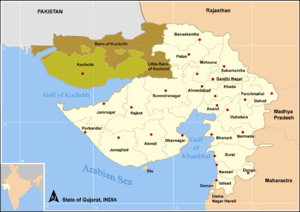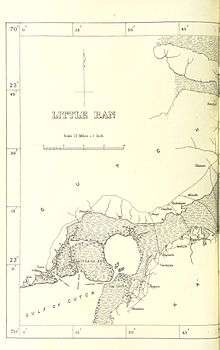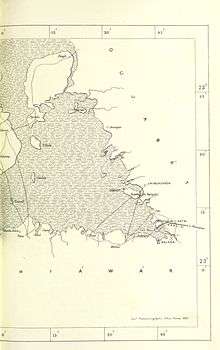Little Rann of Kutch


Little desert of Kutch[1][2] is a salt marsh which is part of Rann of Kutch in Kutch district, Gujarat, India.


Indian Wild Ass Sanctuary


It is famous as the world's last refuge of the Indian wild ass (khur) for the conservation of which it has been declared as the Indian Wild Ass Sanctuary. Though a bleak landscape it is rich in biodiversity and is an ecologically important area for wildlife and many local and migratory waterbirds like cranes, ducks, pelicans, flamingos and land birds like sandgrouse, francolins and the Indian bustards.It is also home to various unique mammals apart from wild ass such as the Indian wolf (Canis lupus pallipes), desert fox (Vulpes vulpes pusilla) and nilgai (Boselaphus tragocamelus).
Biosphere reserve - world heritage site
It is nominated by the forest department to be a biosphere reserve which are areas of terrestrial and coastal ecosystems internationally recognized within the framework of UNESCO's Man and Biosphere (MAB) programme. it will focus on conserving biological diversity, research, monitoring and providing sustainable development models, the proposal has been sent to and listed at UNESCO.[3][4][5]
Economy

Salt panning
.jpg)
There is traditional commercial salt panning[6] activity in the region which the state of Gujarat's Forest Department wants to discourage as it is considered a threat to ecology of the region, wildlife and to the endangered Indian wild ass.
Shrimp farming
The area is also being used to farm shrimp which is more profitable then salt panning, again this activity is discouraged by the forest department.
Damming Rann of Kutch
Gujarat government is studying to dam the 1.26 km stretch of Hadakiya Creek of Rann of Kutch area so that impounded monsoon water is used for recreational and fisheries purposes.[7]
Wildlife sanctuaries and reserves of Kutch
From the city of Bhuj various ecologically rich and wildlife conservation areas of the Kutch / Kachchh district can be visited such as Indian Wild Ass Sanctuary, Kutch Desert Wildlife Sanctuary, Narayan Sarovar Sanctuary, Kutch Bustard Sanctuary, Banni Grasslands Reserve and Chari-Dhand Wetland Conservation Reserve etc.
See also
References
- ↑ Needed in the Little Rann of Kutch, a marketing strategy worth its salt to help the Agariyas (2 page article online); by Adam Halliday; Jul 15, 2009; Indian Express Newspaper
- ↑ RTI revelation: govt has no data on Little Rann of Kutch (2 page article online); by Kamran Sulaimani; Feb 03, 2009; Indian Express Newspaper
- ↑ Nomination entry - UNESCO World Heritage Centre
- ↑ Kutch gets biosphere reserve status - The Greater and Little Rann of Kutch have finally got the much-awaited status of biosphere reserve.
- ↑ Kutch’s wild ass habitat may soon get heritage label (2 Page article online); by DP Bhattacharya; Jul 26, 2007; Indian Express Newspaper
- ↑ The salt-panners of the little Rann; kuensel online; Nov 16, 2009; asiaone news; Singapore Press Holdings
- ↑ "Eye on 2019 polls? Tycoon discusses with Modi, Amit Shah Asia's biggest Rann Sarovar sweet water lake in Gujarat". Retrieved 9 June 2018.
- "Rann of Kutch seasonal salt marsh". Terrestrial Ecoregions. World Wildlife Fund. This text was originally published in the book Terrestrial ecoregions of the Indo-Pacific: a conservation assessment from Island Press. Also see: World Wildlife Fund, ed. (2001). "Rann of Kutch seasonal salt marsh". WildWorld Ecoregion Profile. National Geographic Society. Archived from the original on 2010-03-08.
Further reading
- The salt of the earth - The Little Rann of Kutch contributes about 60 per cent of the salt manufactured in the country. But Gujarat’s politicians have done little for the Agariya community that produces it.; by Manas Dasgupta; Apr 23, 2009; The Hindu, Online edition of India's National Newspaper
- Wild asses population rises by 4%; TNN; 11 April 2009; Times of India
- Wild Ass vulnerable to flu; by TNN; 9 April 2009; Times of India
- Wild ass census to kick off from April 5; TNN; 31 March 2009; Times of India
- Bleak future for traditional salt; by Anosh Malekar; February 21, 2009; Courtesy : Infochange News & Features; ComodittyOnline
- Kutch gets biosphere reserve status - The Greater and Little Rann of Kutch have finally got the much-awaited status of biosphere reserve.; Himanshu Kaushik, TNN; 22 Jul 2008; Economic Times; Times of India
- Agariyas’ wait for land rights continues even after intervention by CMO; Express news service; Mar 19, 2008; Indian Express Newspaper
- Kutch Branch Canal through sanctuary not to hamper movement of wild ass; BASHIR PATHAN; Feb 16, 2008; Indian Express Newspaper
- Kutch’s wild ass habitat may soon get heritage label (2 Page article online); by DP Bhattacharya; Jul 26, 2007; Indian Express Newspaper
- Salt-makers in Gujarat face eviction; by Virendra Pandit; Apr 09, 2007; Business Line, Business Daily from THE HINDU group of publications
- Wild ass robs agarias' livelihood; February 15, 2007; Rediff India Abroad
- Indian Wild Ass Sanctuary; SANCTUARY SPOTLIGHT; Mar 04, 2006; The Hindu, Online edition of India's National Newspaper. Also posted at
- Japanese duo does donkey work in Rann - ‘‘The female donkeys are left by the maldhari’s on the island of Plaswa village in the Rann of Kutch for about three months during the monsoon. Here, the Wild Ass, a protected species, breed with the female donkeys leading to the birth of hybrid donkeys which are taller than their mothers and wilder than their fathers,’’ says Dr R Kimura who has been a visiting researcher at the Equine Museum of Japan for the past two decades.; by Rupam Jain; November 3, 2003; Indian Express Newspaper. Also see
- Officials gear up for wild ass census; by TNN; 28 November 2003; Times of India
- Wild ass being robbed of its run of the Little Rann; by ANAND SUNDAS; March 8, 1999; Indian Express Newspaper
- Salt In The Wounds - Gandhi's historic Dandi march has bypassed them. Gujarat's salt workers are caught up in a maze of abysmal living conditions, ignorance and neglect. By SAIRA MENEZES; Mar 02, 1998;Outlook India Magazine